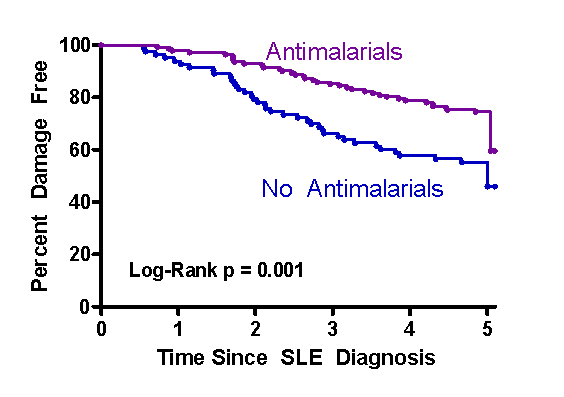Session Information
Session Type: Abstract Submissions (ACR)
Background/Purpose:
Studies in the last 20 years have demonstrated that antimalarials (AM) prevent flares, protect from damage accrual, reduce the risk of thrombosis and increase survival, making them one of the cornerstone treatments for lupus. The aim of this study was to examine whether damage accrual, measured with the SLICC/ACR DI, over a 5 year period is reduced with the previous use of AM.
Methods:
The present study was designed as a nested case-control embedded in an inception cohort of patients with SLE from our Lupus Clinic database, a long term prospective observational cohort study. All subjects fulfilled 4 of the ACR classification criteria or 3 ACR criteria plus having a histological lesion indicative of SLE.
All patients who had SLICC/ACR DI of 0 at inception and developed first damage in the time between the initial and the last follow-up visit at 5 years were considered cases. Two controls, comprising lupus patients in whom damage did not develop, were identified for each case and matched for known confounders for the development of damage: age, sex and disease activity at enrolment measured by the SLEDAI-2K.
AM exposure was classified as never or ever if patients were on either chloroquine or hydroxychloroquine at any visit prior to the onset of damage or during the 5 year interval for the controls.
Comparisons between cases and controls were made using descriptive statistics. Time to presence of damage was compared using Kaplan-Meier curves and time-dependent covariate proportional hazard models.
Results:
719 patients constituted the inception cohort. 490 had the first SLICC/ACR DI measure available within the first year and equal to 0. From the 354 who had at least 5 year follow-up in the clinic, 77 developed damage during the study period and 75 could be matched to 150 controls with no damage.
At first clinic visit, there were 84% women in both groups, with a mean age of 38.5 years in both groups and a SLEDAI-2K of 10.9 in the cases and 9.5 in the controls.
In the univariate analysis AM use was associated with a protective effect for the development of damage (cases 49.3% vs controls 70.7% p=0.002).
Analyzing the damage free survival with Kaplan-Meier curve, AM prolonged the time to damage accrual.
In the proportional hazard regression model, AM usage prior to the onset of damage reduced the probability for damage (HR 0.60 95%CI 0.38-0.95 p=0.03).
In further adjusting for potential risk factors (sex, age at diagnosis, disease duration, SLEDAI-2K) in the time-to-event regression analysis, AM was protective (HR 0.62 95%CI 0.39-0.99 p<0.05) and SLEDAI-2K at each visit increased the risk of damage (HR 1.05 95%CI 1.02-1.09 p<0.005).
Conclusion:
AM is protective for damage accrual in SLE patients during the first five years of the disease, supporting their use at diagnosis of SLE.
Disclosure:
I. Ruiz-Arruza,
None;
D. D. Gladman,
None;
D. Ibanez,
None;
M. B. Urowitz,
None.
« Back to 2012 ACR/ARHP Annual Meeting
ACR Meeting Abstracts - https://acrabstracts.org/abstract/antimalarials-protect-systemic-lupus-erythematosus-patients-from-damage-accrual-during-the-first-five-years-of-the-disease/

